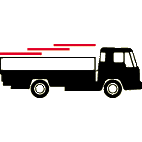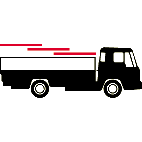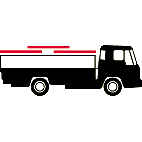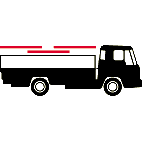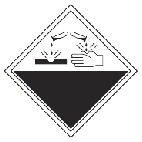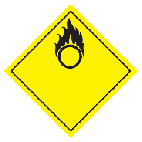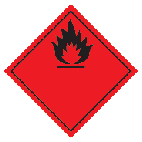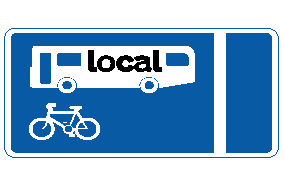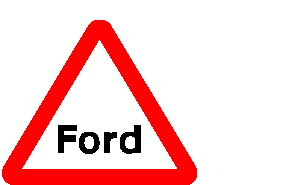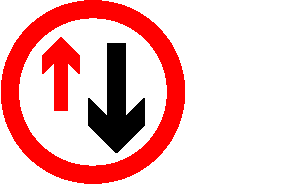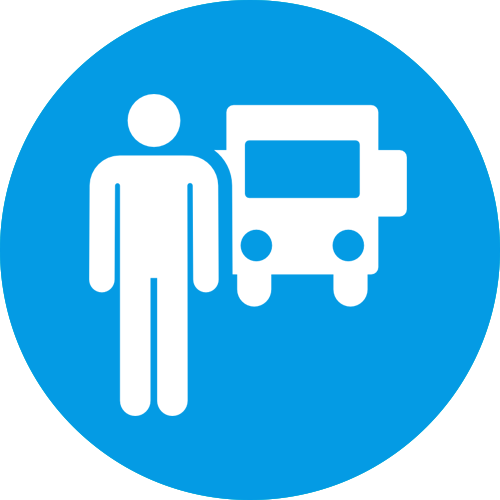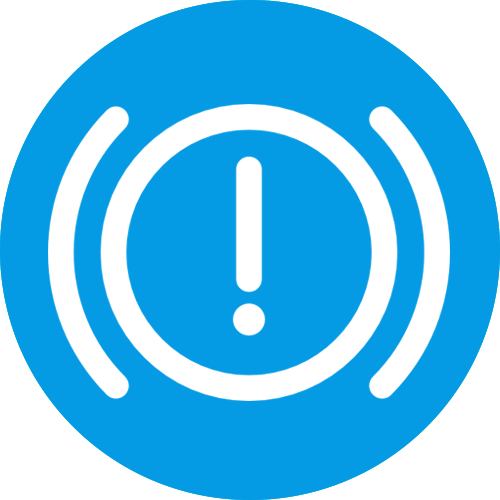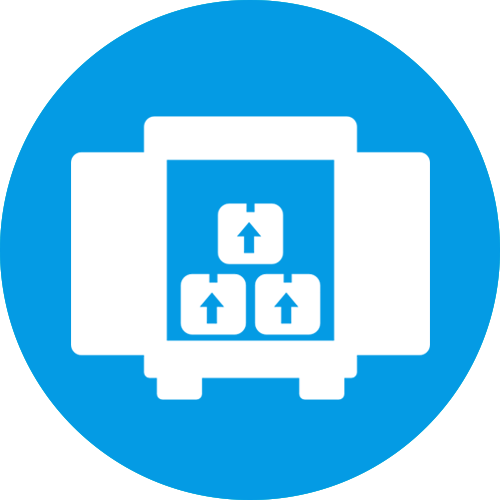
Free LGV Theory Test
You have 115 minutes (1 hour 55 minutes) to answer 100 multiple choice LGV theory test questions. You must score at least 85 out of 100 to pass the test. Answers may be checked after each question or you can wait until the end of the test to view your results. Best of luck!
Click on an answer to view the correct choice along with the explanation.
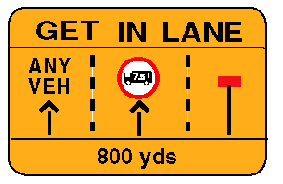
B
C
D
Explanation: Lanes at roadworks often have weight restrictions to keep larger vehicles in the left-hand lane. The lanes through the roadworks are often narrow and therefore not wide enough for large vehicles to pass each other safely. Always look for restriction signs at roadworks. They're usually placed well in advance to give you time to move safely into the correct lane in good time.
B
C
D
Explanation: All vehicles over 7.5 tonnes maximum authorised mass must have markings on the rear of the vehicle. These markings are rectangular and are coloured red and yellow. They're there to inform other road users of the characteristics of your vehicle. The markings should be kept clean so that they can be seen clearly at all times, especially at night and in poor visibility.
B
C
D
Explanation: If you're using a vehicle equipped with an analogue tachograph, you'll need at least one chart for every 24 hours. Your employer should supply you with enough tachograph charts for your entire journey.
B
C
D
Explanation: While driving on a building site, bricks, mud or other debris can become lodged between a lorry's double rear wheels. When you leave the site and increase your road speed, anything lodged between the tyres could be thrown out. This flying debris can be a hazard for drivers of following vehicles and can create dangerous road conditions, especially for motorcyclists.
B
C
D
Explanation: ISO (International Standards Organization) cargo containers should only be carried on lorries or trailers with the appropriate securing points. These are designed to lock into the container body.
Explanation: Keep a check in your mirrors as you're driving to make sure that the sheets are secure. Air can force itself under the sheets and work them loose.
B
C
D
Explanation: If the load is sheeted incorrectly, the wind may get underneath a sheet, making it flap about. This is dangerous, as it can catch unsuspecting pedestrians or cyclists, and it can also seriously reduce the driver's view of what's happening behind.
B
C
D
Explanation: Modern tankers are fitted with baffle plates inside the tank compartment. These help to minimise the movement of liquids and, therefore, reduce the 'wave effect'.
Explanation: Jack-knifing occurs when the tractor unit is pushed by the semi-trailer pivoting around the coupling (fifth wheel). This is more likely to occur with an unladen vehicle.
B
C
D
Explanation: Short-wheelbase vehicles will bounce more noticeably than some long-wheelbase vehicles when empty. This can affect braking efficiency and all-round control.
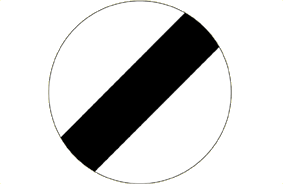
B
C
D
Explanation: The national speed limit for a goods vehicle exceeding 7.5 tonnes on a single carriageway road in England and Wales is 50 mph. In Scotland, the limit is 40 mph. The national speed limit varies for different vehicle categories. You must know the limit that applies to the vehicle you're driving.
B
C
D
Explanation: The forces acting on a lorry will try to move it in a straight line as it enters a bend. The greater the weight, the greater the force. If you're going too fast, there's a danger that you could lose your load or tip over.
Explanation: You should tell telephone companies about your intended route when planning the movement of loads over 5.25 metres [17 feet 6 inches] high. You should tell them in plenty of time before making the journey.
B
C
D
Explanation: The forces that act on your vehicle if you brake while cornering can lead to instability and may cause trailer swing. You should try to plan ahead so that you brake smoothly and in good time as you approach a bend.
B
C
D
Explanation: When getting out of your lorry cab, it's essential that you check it's safe to dismount by checking your mirrors and looking out for traffic. When you're safely down, it's then a good idea to walk round and check your tyres, load, lights, brake lines, electrical connections, etc.
Explanation: Keeping the centre of gravity as low as possible will improve the handling of a car transporter. Top-heavy loads are more unstable and require more care when turning and cornering.
B
C
D
Explanation: Severe braking or selecting a gear too low for your road speed can cause the tractor unit to slow more quickly than the trailer. The trailer can then pivot around the coupling (fifth wheel), causing the vehicle to jack-knife. Jack-knifing is more likely to occur with an unladen vehicle, particularly on a bend or curve.
B
C
D
Explanation: You should take precautions against dropping mud on the road, because it's a hazard to other road users. It's also an offence for which you could be prosecuted.
B
C
D
Explanation: When connecting a three-line tractor unit to a two-line trailer, the blue line is the one that shouldn't be connected to the trailer. This is the auxiliary line. Always follow the manufacturer's advice: it may be necessary to reconnect the extra line to the tractor unit.
B
C
D
Explanation: Load security is one of the many responsibilities of the driver. When choosing a site to park your vehicle overnight, you should always look for a location that's legal and well lit. Many allocated lorry parks are patrolled by the police or security firms.
B
C
D
Explanation: Whenever visibility is reduced, use dipped headlights to make your vehicle easier to see. During and after heavy rain, you should also reduce speed and increase your distance from the vehicle in front.
B
C
D
Explanation: The size and design of some cabs can create blind spots. This is especially true of a sleeper cab. A quick sideways glance might show something you can't see in your mirrors, especially when traffic is merging.
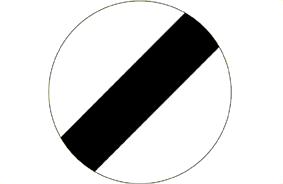
B
C
D
Explanation: In England and Wales, the national speed limit for lorries over 7.5 tonnes maximum authorised mass on a single carriageway road is 50 mph. In Scotland, the limit is 40 mph.
Explanation: The hours of operation of Red Routes vary from one area to another. As a rule, you mustn't stop on a Red Route, but there may be special marked boxes where loading and unloading can be carried out at certain times. Look out for signs giving information about the restrictions in place.
B
C
D
Explanation: A fifth wheel must be maintained properly. It requires regular lubrication and inspection. This should be carried out monthly or every 10 000 km - whichever comes first.
Explanation: Poorly maintained engines use more fuel and emit more exhaust fumes than those that are well maintained. Filters need to be changed on a regular basis. Remember that members of the public are encouraged to report vehicles emitting excessive exhaust fumes.
B
C
D
Explanation: Overloading a vehicle is dangerous. Your stopping distance will increase, and your vehicle could become unstable and difficult to control. You'll need to work out the payload. Do this by taking away the kerbside weight from the maximum authorised mass (MAM). This will give you the maximum weight you can carry.
B
C
D
Explanation: As items are unloaded from the rear of the vehicle, weight will be transferred to the front axle. Take care that this axle doesn't become overloaded. You may need to redistribute the load.
B
C
D
Explanation: It's compulsory for drivers and passengers to wear seat belts. However, if you're making deliveries that are less than 50 metres apart, you may leave the seat belt undone. It would be impractical to keep fastening and unfastening your seat belt over such short distances.
Explanation: Vehicles carrying dangerous or hazardous goods need to have markings on them that clearly identify the load. This could, for example, help the emergency services to deal with any incident quickly and safely.
Explanation: When a full diesel fuel tank heats up, the fuel expands and can be forced out of the breather vent and onto the road. This wastes fuel and makes the road surface very dangerous for other road users.
Explanation: It's vital that you give yourself enough separation distance when driving on icy roads - ten times as much as in normal conditions. You should brake gently to reduce the risk of losing control.
Explanation: The driver must take responsibility and follow the drivers' hours and tachograph rules. Failure to do so can result in legal action and penalties - such as a fine.
B
C
D
Explanation: If the tachograph on your vehicle becomes faulty, you should take it to an approved tachograph repairer as soon as possible. If you can't return to your base within a week of finding the fault, it must be repaired while you're away. While the tachograph is faulty or broken, you must keep a manual record of your activities.
B
C
D
Explanation: The headroom under bridges in the UK is at least 5 metres [16 feet 6 inches], unless otherwise stated. Where the overhead clearance is arched, this headroom is normally only between the limits marked.
B
C
D
Explanation: Cold water will cool the burning tissue and help prevent further damage. It will also reduce swelling, minimise shock and alleviate pain. Use water, or any other liquid, that's clean and non-toxic.
B
C
D
Explanation: If you notice any missing wheel nuts, park and phone for assistance. It's essential that all wheel fixings are in place and tightened to the torque specified by the manufacturer. Checks should be made before you start any journey, but make a visual check every time you start up again after a rest stop.
Explanation: You should check your tyres as part of your routine check of the vehicle. A damaged tyre - such as one with exposed ply - can have a major effect on your vehicle's handling and will make it a danger to you and other road users.
B
C
D
Explanation: Keeping your vehicle's tyres in good condition will give them a good grip on the road and will improve the vehicle's overall stability. Each tyre must have at least the minimum legal depth of tread across three-quarters of its width. Renew tyres well before they wear to less than that.
Explanation: It's an offence to leave a vehicle unattended on a public road with the engine running. Take care if you have to open the cab door directly into the road. Look for passing traffic - especially cyclists or motorcyclists - that may not be visible in your mirrors.
Explanation: It can be dangerous for vehicles passing close by if you open the door carelessly. Always look properly to make sure that it's safe - checking the blind spots as well as using the mirrors - before you get out of the cab.
B
C
D
Explanation: Always use the MSM routine when you're approaching a hazard.
M - Mirrors: check the position of the traffic behind you..
S - Signal: signal your intention to slow down or change course in good time..
M - Manoeuvre: a manoeuvre is any change in position, from slowing or stopping the vehicle to turning off a busy road.
Explanation: Some lanes are set aside for certain types of vehicle. Signs and road markings show the authorised vehicles in words or pictures. There's usually also a sign showing the times that the lane is in operation. Some lanes might only be in operation for a short time. Check the sign and only use the lane if you're allowed to do so.
Explanation: This sign is found where a shallow stream crosses the road. Heavy rainfall could increase the flow of water. If the water looks too deep or the stream has swelled over a large distance, stop and find another route.
Explanation: Suspension faults may result in road damage. Road-friendly suspension reduces the impact on the environment, the road surface and under-road services.
Explanation: When you see this sign, you must give way to traffic from the opposite direction, regardless of the size of your vehicle.

B
C
D
Explanation: Double red lines indicate that you're on a Red Route and in a no-stopping area. Red Routes also have single red lines, with signs showing the times that restrictions are in force. There are also parking and loading boxes, which have signs explaining the restrictions that apply.
B
C
D
Explanation: The maximum driving period under EU rules is 4 hours 30 minutes. After this, you must take a break of at least 45 minutes. Planning your route will allow you to take your statutory rest periods in a safe place, such as a service area, where you can get food, drink and a rest.
Explanation: It's very important to know the correct fire extinguisher to use. They'll carry a coloured label or badge telling you their contents. Make sure you learn which extinguisher is which, as using the wrong one could be dangerous and may spread the fire further. For example, you should never use a water extinguisher on burning oil.
Explanation: In severe weather conditions, you should be aware of the dangers of fallen trees or damaged branches that may fall on your vehicle. Be prepared in case a fallen tree is lying across the road just around a bend.
B
C
D
Explanation: To comply with the law, all lights must be in good working order, even in daylight when they're not being used. Before you set out, make sure that everything is working and get any faulty lights fixed. You may need to use your headlights or other lights if you're delayed or find yourself driving in conditions of reduced visibility.
B
C
D
Explanation: It's a legal requirement that your tyres have at least the minimum permitted depth of tread and are in good condition before you start any journey. Make sure that you inspect them before setting off, and at regular intervals.
B
C
D
Explanation: It's a legal requirement that information about a vehicle's height can be seen by the driver from their seat. It's important to know the height of your vehicle so that you can avoid any height restrictions on your route.
B
C
D
Explanation: In windy weather, try to avoid routes where you would have to drive across suspension bridges and other exposed stretches of road. Plan a route that takes you across lower ground and where you'll be less exposed.
Explanation: An illness that could affect you while you're driving, such as a heart condition, may make it unsafe for you to drive. You must tell DVLA if you develop any serious illness or disability that's likely to last more than three months and that could affect your driving. Partial blindness and mental disorders can also prevent you from getting a driving licence for large vehicles.
B
C
D
Explanation: When refitting a wheel, the nuts should be tightened to the correct torque. They should be rechecked after about 30 minutes if the vehicle hasn't moved, or after 40 to 80 km (25 to 50 miles) of driving.
Explanation: Always plan ahead and take note of gradient warning signs. On downhill gradients, you can help control your vehicle's speed and avoid brake fade by selecting a lower gear in good time.
B
C
D
Explanation: On motorways, there are often exposed stretches of road where vulnerable vehicles can be affected by side wind. A gust of wind can even blow a motorcyclist out of their lane. Try to anticipate how the wind may affect others and give them plenty of room.
B
C
D
Explanation: You must check the nearside mirror during and after overtaking a motorcyclist. Make sure that the rider is still in control and that your vehicle's draught hasn't caused them to lose their balance.
B
C
D
Explanation: In very wet conditions, tyres may be unable to clear all the water from their path. This can result in a layer of water building up between the road and the tyre - a situation known as aquaplaning. To regain control, ease off the accelerator and, as the vehicle slows, the tyres should regain their grip. It's safer to reduce the risk of aquaplaning occurring by driving more slowly in very wet weather.
B
C
D
Explanation: Other road users can be affected by the spray from large vehicles, severely reducing their vision. Always take care when you need to change lanes: signal in good time and watch your mirrors carefully before pulling out in these conditions.
B
C
D
Explanation: Even though the warning light is showing, there may be sufficient pressure to release the parking brake. However, you mustn't do this, because there may not be enough air pressure to operate the service brake.
B
C
D
Explanation: Anti-lock brakes are a driver aid, and can help you maintain steering control while braking. However, you mustn't rely on them to get you out of trouble or expect to be able to make sudden direction changes if you're going too fast.
Explanation: An endurance brake can help to control your speed on long downhill slopes without using the service brake. Reducing the use of the service brake helps to prevent the brakes from overheating and reduces the risk of brake fade.
B
C
D
Explanation: If a police officer signals for you to stop, stop as soon as possible in a safe place on the left.
B
C
D
Explanation: Telephone calls can distract you, meaning that you're not in proper control of your vehicle. If you need to use a telephone when driving, find a safe place to stop first. Better still, use a phone answering service and listen to your messages at the end of your journey.
Explanation: You should always try to stop, if it's safe, for people waiting at pedestrian crossings. However, avoid waving them to cross. Another driver may not have seen them, may not have seen your signal or may not be able to stop safely.
B
C
D
Explanation: Never drive after taking drugs you don't know about. They might affect your judgement and perception - and, therefore, endanger lives.
B
C
D
Explanation: If you're travelling on a long journey, plan your route before you leave. This will help you to
- be decisive at intersections and junctions
- plan your rest stops
- know approximately how long the journey will take.
Explanation: When driving downhill, gravity will cause the vehicle to increase speed. More braking effort will be required, and stopping distances will increase.
Explanation: Tailgating is very dangerous because there isn't enough room to stop if an emergency arises. It's also intimidating for the driver that you're following.
B
C
D
Explanation: Traffic behind that's returning from the right-hand lane is a hazard to be aware of before you move into the middle lane to overtake. Checking your blind spot can help you see these vehicles before you commit to changing lanes.
Explanation: When you have to straddle the lanes at small roundabouts or junctions, always signal in good time. Be alert for inexperienced road users who may, without realising, put themselves into a dangerous position.
Explanation: Plan your overtaking carefully. The weight of your vehicle, combined with the restrictions imposed by a speed limiter, is likely to make your vehicle lose speed on uphill gradients. You should take this into consideration before attempting to overtake another moving vehicle.
B
C
D
Explanation: Elderly pedestrians may have impaired judgement, hearing and/or vision. Be aware that, if they do start to cross, they could take more time to do so.
Explanation: Although they're advised to wear clothing that's bright or reflective, motorcyclists often wear clothing that's mainly black. This can make them difficult to see, so you must look carefully for them.
Explanation: Before driving into a tunnel, you should take off your sunglasses. If you don't, you'll find that your vision is restricted - even in a tunnel that appears to be well lit.
Explanation: Before entering a tunnel, you should switch on your dipped headlights; these help you to see and be seen. In many tunnels, using headlights is a legal requirement. You should also remove your sunglasses before you drive into a tunnel.
B
C
D
Explanation: Switch off your fog lights when fog starts to clear and visibility improves to more than 100 metres (328 feet). Don't leave your fog lights on when the fog has cleared, because they can cause unnecessary glare or distraction for other drivers.
B
C
D
Explanation: White reflective studs separate each of the lanes. Red studs mark the left-hand edge of the carriageway, where the hard shoulder begins.
Explanation: While you're using a phone, your attention will be divided between the call and the road. This means you're unable to take in all that's happening around your vehicle. You need to be concentrating on your driving all of the time, and especially when dealing with a hazard.
Explanation: Trams are becoming increasingly common in large towns and cities, as the move to more environmentally friendly transport continues. They may either cross the road you're driving on or share it with you. Always be aware of their virtually silent approach, and look out for places where you may be required to give way to them.
B
C
D
Explanation: Tailgating' - travelling too close to the vehicle in front - is very dangerous, because it doesn't give you enough distance to stop safely. Leave at least a two-second gap in good conditions, and increase this to four seconds in wet weather.
B
C
D
Explanation: To help a casualty who isn't breathing, you should remove any obstructions from their mouth and tilt their head back slightly. These actions will help to keep their airway clear and maintain the correct position if mouth-to-mouth resuscitation is required.
B
C
D
Explanation: DVSA and the police carry out frequent roadside checks of commercial vehicles. Where serious defects are found, the vehicle is taken out of use until they're put right. Details of the prohibition are shared with the traffic commissioner.
B
C
D
Explanation: When emerging, if you can't see, don't go. Be aware that there could be an approaching cyclist or motorcyclist hidden by parked vehicles. Edge out very slowly, checking in all directions, and be ready to stop.
B
C
D
Explanation: Stay back and allow the cyclist to proceed. You mustn't cut across in front of them. Also be aware of any cyclists who may try to pass on your left as you slow for the turn.
B
C
D
Explanation: In slow-moving traffic, particularly on dual carriageways or motorways, always be on the lookout for motorcyclists who approach from behind and filter through narrow gaps between vehicles.
Explanation: Junctions are especially risky for some road users - particularly motorcyclists, cyclists, pedestrians and mobility-scooter users. Their small size means they're easily hidden from view. At busy junctions, scan the near, middle and far distance to identify all hazards before emerging with a long vehicle.
Explanation: If you're disqualified from driving because you were two-and-a-half times over the legal limit, you'll be classified as a high-risk offender. Before you can regain your licence, you'll have to satisfy the Driver and Vehicle Licensing Agency (DVLA) that you don't have an alcohol problem.
Explanation: If a school crossing patrol steps out into the road with a 'stop' sign, you must stop. Don't wave anyone across the road or get impatient and rev your engine.
Explanation: In queuing traffic, motorcyclists may take the opportunity to filter between the lanes. Be aware that they may pass on either side and very close. Stay alert and always check your mirrors and blind spots before moving off, changing lanes or turning.
Explanation: Four amber lights flash in alternate horizontal pairs to provide a warning and to draw the driver's attention to the message displayed.
B
C
D
Explanation: Avoiding busy times means that you're not adding needlessly to traffic congestion. Other advantages are that you'll use less fuel and you may have an easier journey, making you feel less stressed.
Explanation: It's a serious offence to drive without insurance. As well as an unlimited fine, you may be disqualified or given penalty points.
Explanation: Digital tachograph driver smart cards are valid for a maximum of five years. You should receive a reminder about three months before the expiry date. However, it's your responsibility to make sure that you apply for a new card at least 15 days before the old one expires.
B
C
D
Explanation: If you apply for a PCV or LGV licence, you must demonstrate that your eyesight is good enough to drive safely. DVLA (or DVA in Northern Ireland) can give you specific information about this. It's your responsibility to tell DVLA or DVA if your eyesight changes or you can't meet the requirements.
Explanation: You have a legal responsibility to make sure that your vehicle is fully roadworthy. Daily walk-round checks give you the chance to look for any defects with your vehicle.
B
C
D
Explanation: You should always leave a safety margin between your vehicle and the one in front. This gap will give you a better view of the road ahead. It will also allow you time to react if the traffic in front changes speed or direction.
B
C
D
Explanation: Make sure you or someone else has called the emergency services. Check the casualties and, if you feel able to give first aid, do so. Alternatively, ask any bystanders if they can help.
LGV Theory Test Practice
LGV Theory Test Questions by Topic
About the LGV Theory Test
Contents
- 1 Free LGV Theory Test
- 2 LGV Theory Test Practice
- 3 LGV Theory Test Questions by Topic
- 4 About the LGV Theory Test
- 5 Driver Certificate of Professional Competence (Driver CPC)
- 6 Multiple Choice Questions
- 7 LGV Hazard Perception Test
- 8 The Result
- 9 After the LGV Theory Test
- 10 LGV Driving Test
- 11 Medical Requirements
Before taking your practical test, you need to pass both parts of the LGV theory test (also known as the HGV theory test). However, the order in which you take them does not matter – and you don’t even need to take them in the same sitting. If you need to take the Driver CPC case studies test, it is possible to sit this before taking any part of the theory test or after completing both parts.
As you begin, you must be aware of the differences between driving smaller vehicles and larger vehicles, such as lorries or buses.
Similarly, you should have a solid understanding of the Highway Code, which includes familiarity with traffic signs, road markings and their meanings. Special effort should be made to be aware of signs informing you of restrictions for buses or lorries.
This knowledge, mentioned above, is assessed through multiple choice questions in the first part of the theory test.
Despite the requirement of passing your LGV theory test before taking the practical test, it is advised that you begin studying for the theory test as soon as you can. But we would warn against actually taking it until after you have gained some practical experience behind the wheel of a large vehicle.
Driver Certificate of Professional Competence (Driver CPC)
The Driver CPC is a qualification, now introduced throughout the European Union, for professional drivers of buses, coaches and lorries. It is now a requirement that drivers of buses, coaches and lorries hold a Driver CPC if they wish to drive these larger vehicles as part of their profession.
To initially qualify, drivers must pass a theory test concerning case studies. This test is taken as well as the multiple-choice theory test, and the hazard perception test. In terms of practical components, an extra practical demonstration test must also be passed in order to obtain a Driver CPC.
Multiple Choice Questions
There are 100 multiple-choice questions in this part of the LGV theory test.
To answer the questions in this part of the test, you must select your answer by either touching the screen or using the mouse provided.
Before beginning the test, you will have an opportunity to practice a few questions – for no more than 15 minutes – to help you get used to the system. Test centre staff will be on hand to assist you if you encounter any problems.
When the test starts, the questions will test your knowledge of several areas concerning road safety, the environment and documents related to driving. In addition, some questions will address other factors specific to the driving of large vehicles, including passenger care and load safety, among others. At any time, only one question will be on the screen, and you will be instructed to mark one correct answer.
To select your chosen answer, you must touch or click the box next to the answer you believe is right. If you change your mind and want to deselect that answer, you need only touch or click it for a second time. You may then choose another answer by touching or clicking a different box.
Take care to read the questions thoroughly and make sure you understand what you are being asked. Try not to rush – you have 115 minutes for this part of the LGV theory test, and remaining calm is key to success. Some questions will require more time than others to answer, but none are designed to catch you out. You will be able to see the amount of time left to complete the test on the screen.
If you have special needs, you may be entitled to extra time. Please ensure that you let us know about this when you book your test.
It is possible to move back and forth between questions, and you may also ‘flag’ questions to remind yourself to look at them again. As explained above, changing your answers is simple if you would like to do so.
Try to answer every question on the test. If you have prepared well, then the questions should be relatively straightforward.
Before this part of the test ends, you can use the ‘review’ feature to check your answers if you have time. Should you wish to finish your test before the full 115 minutes have passed, then you can touch or click the ‘review’ button. Then, select the ‘end’ button on the review screen. You will see this screen after touching or clicking the review button.
LGV Hazard Perception Test
The LGV hazard perception test contains several computer-generated image (CGI) video clips shown from the point of view of a driver. For this part of the test, you will use the mouse provided.
Before beginning this part of the test, you will see a brief CGI presentation which explains the format of the test and includes a sample clip for you to see. After watching this, you will have a clearer understanding of what you need to do for this test. If you would like some clarification or if you missed a part, you may replay these initial videos.
In the test itself, you will see 19 CGI video clips. Each one will contain one or more developing hazards. This test assesses your ability to spot hazards early, so you should press the mouse button as soon as you see a hazard developing, which may require you, as the driver, to change speed or direction or take some other action. The earlier you notice these developing hazards, responding with a click of the mouse, the higher your score will be. There are 20 hazards available for you to earn points from.
When you respond, the video will continue to play unchanged, but a red flag will appear at the bottom of your screen to acknowledge your response.
Before each new clip starts playing, there will be a 10-second pause to enable you to observe the new scenario and get your bearings.
You will be given 25 minutes to complete the LGV hazard perception test. No extra time is available for the hazard perception component and you will not be allowed to replay any of the clips you watched after the test began. This is because, in reality, you only get one chance to see a hazard on the road while driving.
The Result
After you have completed both parts of the LGV theory test, you should receive your result within 10 minutes. This should also include your module score.
The multiple-choice and hazard perception tests, while independent in terms of the order or sitting you take them in, must both be passed in order to pass the theory test. If you need to take the Driver CPC case studies test, this may be done either before or after completing both the multiple-choice and hazard perception tests. Both the theory test and, if you’re taking it, the case studies test must be passed before you take the practical test.
After the LGV Theory Test
After passing both parts, you will receive a pass letter in the post. It is important that you keep this safe because it will contain the pass certificate number that you’ll need to allow you to book your practical test.
The pass certificate will be valid for two years, beginning on the date that you passed the first part of the LGV theory test (whichever part you took first). Therefore, you must pass the practical test – for the category of vehicle you intend to drive – within this two-year window. If you fail to do so, you will have to sit both parts of the theory test again and pass them before you are able to book your practical test again.
Drivers who wish to drive professionally will also need to pass the Driver CPC case study test, as we have mentioned above. This case study test is, again, an on-screen test administered at a test centre.
The case studies presented in the test are based on situations that you may experience on the job. This format will test your knowledge and basic understanding by assessing how effectively you apply your skills to real life.
The questions you will have to answer will be based on these scenarios. You will be asked to answer them in one of two ways:
- Choosing the correct answer in a multiple-choice question
- Clicking an area of an image or photograph
The test, which includes introductory screens, lasts 90 minutes. You will be examined on 6-8 case studies, each with 5-10 questions attached.
LGV Driving Test
The next stage in your development as a driver is to prepare for and take the practical driving test. If you intend to drive a large vehicle professionally, you must take two practical tests as part of the Driver CPC qualification:
- The Licence Acquisition Practical Driving Test
- The Driver CPC Practical Demonstration Test
Medical Requirements
As a driver of large vehicles, you will likely be responsible for safely transporting passengers or goods. Therefore, it is imperative that you meet detailed and specific medical criteria. These medical requirements apply to both large goods vehicles (LGV) and PCV licences.
To hold either a PCV or LGV licence, your eyesight must meet the high standard required.
If you have a disability, you may drive a vehicle if it has been specially adapted for you and your needs. You should otherwise be fit and must not suffer from any condition affecting your ability to control a large vehicle.
You are, by law, required to undergo a medical assessment conducted by a doctor. The doctor must then complete a D4 medical report form (DLM1 in Northern Ireland), which must be sent in with your licence application.



